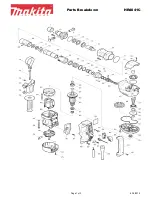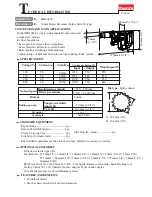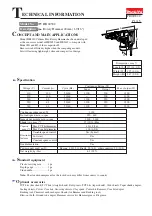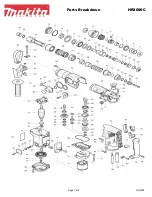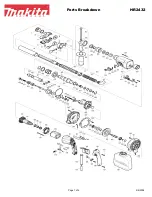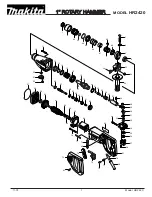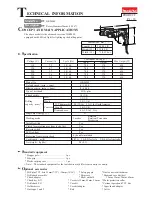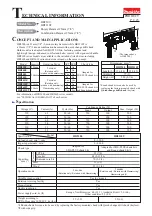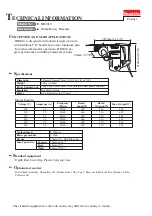
5
4. To freely rotate the bit to the desired angle for
hammering only, turn the selector lever to the
symbol. Then, follow step 3.
NOTE:
To engage the hammering mechanism, main-
tain pressure on the bit. When pressure on the bit is
released, the hammering action will stop.
Starting and Stopping
1. To
start
the tool, grasp the handle(s) firmly and
pull the trigger.
2. To
stop
the tool, release the trigger. Make sure
the tool comes to a complete stop before laying
the tool down.
WARNING
Applying greater pressure does not
increase the tool's effectiveness.
If the applied working pressure is too high, the
shock absorber will be pushed together making
the vibrations to the handle noticeably stronger.
Operator Force
The Anti-Vibration System provides the operator with
comfort without sacrificing power or performance.
Ideal operator force compresses the bellows slightly
and allows the tool to work aggressively while the
handle remains steady.
Excessive force compresses the bellows significantly
and reduces vibration dampening. Users will be able
to feel the difference and should adjust the force to
the handle accordingly.
Too Little
Correct
Too much
force
force
force
Using the Control Switch
Always allow the motor to come to a complete stop
before using the control switch to avoid damage to
the tool.
For
forward
(clockwise) rotation, push in the control
switch from the right side of the tool. Check the direc
-
tion of rotation before use.
For
reverse
(counterclockwise) rotation, push in the
control switch from the left side of the tool. Check
direction of rotation before use.
Operating
Position the tool, grasp the handles firmly and pull
the trigger. Always hold the tool securely using both
handles to maintain control. This tool has been de
-
signed to achieve top performance with only moder-
ate pressure. Let the tool do the work.
If the speed begins to drop off when drilling large or
deep holes, pull the bit partially out of the hole while
the tool is running to help clear dust. Do not use water
to settle the dust since it will clog the bit flutes and
tend to make the bit bind in the hole. If the bit should
bind, a built-in, non-adjustable slip clutch prevents
the bit from turning. If this occurs, stop the tool, free
the bit and begin again.
Cold Starting
If this tool is stored for a long period of time or
at cold temperatures, it may not hammer ini-
tially because the lubrication has become stiff.
To warm up the tool:
1. Insert and lock a bit or chisel into the tool.
2. Pull the trigger and apply force to the bit or chisel
against a concrete or wood surface for a few
seconds. Release the trigger
3. Repeat until the tool starts hammering. The colder
the tool is, the longer it will take to warm up.
Using Rotary Percussion Core Bits
Core Bits are useful for drilling large or long holes
in concrete. MILWAUKEE Heavy-Duty Core Bits
have heat-treated steel bodies with durable carbide
tips. These core bits are specially designed for fast,
accurate drilling with combined hammering and
rotary action.
1. Clean and lubricate the threads on the adapter and
core bit to make later removal easier. Thread the
adapter shank to the rear of the core bit.
2. Push the guide plate onto
the pointed end of the
center pin. Insert the
center pin and guide
plate assembly into the
core bit. Be sure the
small end of the center
pin is securely placed
into the hole in the center
of the core bit.
For LHS systems, screw
the threaded end of the
centering bit into the core
bit.
NOTE:
If using an ex-
tension, first thread the
adapter shank to the
extension. Then thread
the core bit to the exten-
sion.
3. Insert the adapter into the
nose of the tool as de-
scribed in “Installing Bits
and Chisels”. Set the
knob to the "hammering
with rotation" setting.
4. Press the centering bit
firmly against your center
mark, hold the tool firmly
and pull the trigger.
NOTE:
If the 48-20-5099
threaded stud is used, or
a center pin and guide
plate are not available,
use a template or
notched board to start
the hole.
5. Start the tool. After drill
-
ing to about the depth
of the core bit teeth, re-
move the center pin and
guide plate from the core bit (not necesary for LHS
system). Resume drilling.
6. To change the core bit, hold the tool upwards,
pointing it away from your body, and run it briefly
in forward to loosen the core bit from the adapter.
NOTE:
To make deeper holes, remove the core bit,
break and remove the core, then resume drilling.
When drilling long or deep holes, after each inch of
penetration pull the bit partially out of the hole while
the tool is running, to help clear dust from the bit
flutes. Dust can clog the bit flutes and can make the
bit bind in the hole. If this occurs, stop the tool, free
the bit and begin again.





















